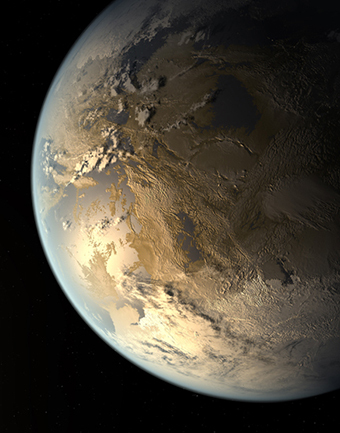Resources
Glossary
Astronomers use special terms to describe the planets beyond our solar system. Below are some of the more common words and phrases you might run across when participating in Exoplanet Watch. Let us know if you encounter other words you don't know, and we will add them to the glossary.
Airmass - A measure of the amount of air along a line of site when observing a star from below Earth’s atmosphere. It matters because the atmosphere scatters and absorbs light. The thicker the atmosphere through which starlight passes, the more the light can be distorted.
Astronomical Unit (AU) - the distance between Earth and the Sun, or about 93 million miles (150 million kilometers).
Astrophysicist - A person who studies objects that are visible in the night sky
Biases - Very short exposure pictures taken with no light falling on the image sensor, used for calibrating images
BJD - Barycentric Julian Date - the day of the year, corrected for differences in Earth’s position with respect to the barycenter of the solar system, used in astronomy to define a very precise date and time
Brown dwarf - A star-like object that is not quite massive enough to burn like a star, but bigger than a planet.
Citizen scientist - A person who volunteers to participate in a scientific activity such as collecting or analyzing data, participating in a group project to learn more than individual scientists could learn on their own
Comp stars - A few stars that are in the same field of view of the target star, of approximately the same brightness, that can be used to compare with the brightness of the target star as an exoplanet passes in front of it. Comp stars chosen should not be variable stars, because their steady brightness is what is being compared with the target star.
Darks - Pictures taken through a telescope with the lens cap on, to filter out noise from the camera sensor
Data - Information collected by a scientific instrument, in our case, a telescope
Egress - The point during an exoplanet transit at which the exoplanet transit ends, once the exoplanet finishes passing in front of the disc of its host star
Ephemeris - (plural: ephemerides) - A table or data file of the calculated positions of an object in the sky at regular intervals throughout a time period
Exoplanet - A planet orbiting a star other than our Sun; also called “extrasolar planet.”
EXOTIC - EXOplanet Transit Interpretation Code - Software that detects exoplanets by measuring the dimming of a star as an orbiting exoplanet passes in front of it.
Filters - Optical filters cover a telescope’s lens or mirror to make it easier to measure the number of photons of selected wavelengths of light. They cut out unwanted colors or wavelengths of light, enhancing details and improving contrast.
FITS or Flexible Image Transport System - FITS is the most commonly used digital file format in astronomy. The FITS standard was designed specifically for astronomical data, and includes provisions such as describing photometric and spatial calibration information, together with image origin metadata.
Flats - Fully illuminated images that have uniform lighting across the whole frame. Used for calibrating a telescope and removing dust spots on a camera sensor.
F-type star - A main sequence star that is somewhat hotter, more massive, and more luminous than our Sun.
Goldilocks Zone - Another name for “habitable zone", from the children’s story, “Goldilocks and the Three Bears.” A region around a star with conditions that are not too hot or too cold, but just right for liquid water to exist.
Habitable Zone - The range of orbital distance from a star at which temperatures would allow liquid water to exist on the surface of a planet with sufficient atmosphere. This range of distance changes depending on the size and temperature of the star. Earth is in the habitable zone of the Sun, one of the reasons our planet has liquid water like oceans and lakes.
Host star - The star an exoplanet orbits around
Hot Jupiter - A giant gas planet in extremely close orbit around its star. Some complete a single orbit—their “year”—in as little as a few Earth days.
Infrared - Electromagnetic radiation with wavelengths longer than the red end of the visible light spectrum, but shorter than microwaves. Some telescopes observe stars using infrared detectors.
Ingress - The point during an exoplanet transit when the whole planet has moved onto the stellar disc
Hot Jupiters - gas giant planets that orbit very close to their host star, giving the planet a high temperature
James Webb Space Telescope - This NASA space telescope, which launched in 2021, is a large infrared telescope with a 6.5-meter primary mirror. It is the most powerful and complex space science telescope ever built. It is sometimes called JWST or Webb.
Kepler Space Telescope - a NASA spacecraft that orbited the Earth and observed one region of space to detect Earth-sized transiting exoplanets. Kepler detected more than 2,600 exoplanets from 2009-2018. Many exoplanets have names starting with Kepler due to their discovery by this orbiting telescope.
Light curve - A graph showing the change in brightness of a star over time as an exoplanet passes in front of it, as seen from the observer or telescope. Other variable stars and supernovae also have light curves, but their shape is different due to how and why the brightness of the light changes.
Light year - The distance light travels in one Earth year (365 Earth days), about 5.88 trillion miles (about 9.5 trillion kilometers). The closest star beyond our Solar System is Proxima Centauri, which is about 4 light years from Earth.
Mass - The mass of a planet is the amount of matter in the planet, which is not always the same as its “size.” Exoplanet masses are measured in comparison to Earth for smaller rocky planets, or Jupiter for big gas planets. The standard unit of mass is the kilogram (kg), and the Earth’s mass is about 5.97 x 10^24 kg.
Observations - Watching something carefully to gain information about it, in this case, looking at the night sky with a telescope and taking a photograph every few minutes, then using a computer to compare the brightness of a star before, during, and after an exoplanet passes in front of it
Orbit - The elliptal, curving, repeating path of an object, such as a satellite, moon or planet, around a space body such as a moon, planet or star.
Orbital Period - The length of time it takes for a planet to orbit its star. The length of the exoplanet’s year, or the time between transits.
Planet composition - What a planet is made of (rocks, minerals, metals and/or gasses)
Radial Velocity - A method used for detecting the amount of “wobble” induced in a star by the gravity of an orbiting planet, or planets. By measuring the stretching and compressing of light wavelengths from the star, as it is pulled in one direction, then another, Earthbound observers can detect extrasolar planets.
Red dwarf star or M dwarf star - A class of small, relatively cool stars, emitting dim, red light. They are the most common type of star, comprising about 75 percent of all stars in the galaxy.
Relative flux - The brightness of a star compared to another star
Spectroscopy - A method of analyzing light by separating it into distinct wavelengths, revealing the identity of its chemical components (by their unique wavelength signatures) to determine the atmospheric components of exoplanets' atmospheres.
Spitzer Space Telescope - A NASA space telescope launched in August 2003 and retired in January 2020. Spitzer observed infrared (heat) radiation from exoplanets, stars, stellar nurseries, the centers of galaxies and the early stages of planetary system formation.
Super-Earths - Rocky planets that are more massive than Earth but smaller than Uranus. One of the most common types of exoplanets discovered so far, with a mass between that of Earth and Neptune. The properties of such planets are largely unknown.
Telescope - Optical equipment consisting of lenses and/or mirrors used for observing distant objects such as stars and planets
Telescope Mount - The part of the telescope system that controls the direction in the sky where the telescope is pointing
Terrestrial - Planets composed mostly of rock (silicates) and metals, like Earth, Venus, Mars, and Mercury. Sometimes also called “rocky” or “telluric.”
Tidally locked - When a celestial body, such as a planet or moon, always has one side facing the body it orbits, such as a star or planet. A tidally-locked planet has a day side facing the heat of its star, and a colder night side facing away. Tidal forces and the star’s gravity “lock” the planet, so that its orbital period is equal to its rotation period.
Transit - When an object passes in front of another object. When an exoplanet crosses the face of its star from the perspective of Earthbound observers. The change in brightness of the star due to the exoplanet can be measured and used to calculate the diameter of the exoplanet.
Transit Depth - The ratio of the area of the planet to the area of the star, related to the change in brightness of the star as the exoplanet passes in front of it. A transit depth of 0.2 means 20% of the star’s brightness is being blocked. Used for calculating the size of the exoplanet, if the size of the star is already known.
Ultra-cool dwarf - Star-like objects with effective temperatures of less than 2,700 Kelvin are referred to as ‘ultracool dwarfs.' This group includes stars with extremely low mass and brown dwarfs, or objects that are not quite massive enough to burn like a star. “Dwarf” is the term for an average adult star, used to distinguish stars like the sun from the giant stars that exist in the universe.
Vmag - Visual magnitude or apparent relative brightness of a star
Water world - Hypothesized extrasolar planets with surfaces completely covered by deep oceans of water.
White dwarf - A dim, dense, compact star; the remnant core that remains after intermediate-mass stars (similar to the Sun) exhaust their nuclear fuel and blow off their outer layers. They are dominated by oxygen and carbon, but often have thin layers of hydrogen and helium.
Subscribe to the Exoplanet Watch Monthly Newsletter here:





